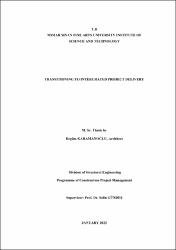Mimar Sinan Güzel Sanatlar Üniversitesi Açık Bilim, Sanat Arşivi
Açık Bilim, Sanat Arşivi, Mimar Sinan Güzel Sanatlar Üniversitesi tarafından doğrudan ve dolaylı olarak yayınlanan; kitap, makale, tez, bildiri, rapor gibi tüm akademik kaynakları uluslararası standartlarda dijital ortamda depolar, Üniversitenin akademik performansını izlemeye aracılık eder, kaynakları uzun süreli saklar ve yayınların etkisini artırmak için telif haklarına uygun olarak Açık Erişime sunar.MSGSÜ'de Ara
Transitioning to intergrated project delivery
| dc.contributor.advisor | Gündeş, Selin | |
| dc.contributor.author | Karamanoğlu, Begüm | |
| dc.date.accessioned | 2022-06-20T20:21:42Z | |
| dc.date.available | 2022-06-20T20:21:42Z | |
| dc.date.issued | 2022 | |
| dc.identifier.uri | https://hdl.handle.net/20.500.14124/1581 | |
| dc.description | Tez (Yüksek Lisans) -- Mimar Sinan Güzel Sanatlar Üniversitesi Fen Bilimleri Enstitüsü, 2022. | en_US |
| dc.description.abstract | Today's construction environment involves the execution of increasingly complex, uncertain projects, which necessitates project teams working under tight schedules and with limited resources. Many studies on construction contracting systems have found the same conclusion: building scopes are expanding and the use of technology in the sector is becoming increasingly crucial; however, traditional contracting systems are falling short of meeting the needs of this expanding industry. Traditional delivery systems are typically used for construction projects: uild (DBB), Design-Build (DB), or Construction Management at Risk (CMR). These methods also fail to satisfy the client due to longer project durations, overruns, poor quality of finished works, and recurring health and safety incidents. Among the stated issues with traditional construction procurement methods are frequent conflicts, aim discrepancy, change orders, rework, antagonistic relationships, arbitrations, and litigations. Over the past two decades, many experts, analysts, and building and management practitioners have collaborated to provide a broad variety of ideas and strategies to solve the problems related to project delivery methods. Inadequate collaboration and cooperation among project resulted in the emergence of systems based on relational contracts such as 'partnering' and 'project alliancing'. The success of these two systems consequently led to the accomplishment of a novel phenomena called the integrated project delivery system . | en_US |
| dc.format.medium | xxvii, 115 sayfa : tablo ; 30 cm. | en_US |
| dc.language.iso | eng | en_US |
| dc.publisher | Mimar Sinan Güzel Sanatlar Üniversitesi, Fen Bilimleri Enstitüsü | en_US |
| dc.rights | info:eu-repo/semantics/openAccess | en_US |
| dc.subject | Bütünleşik proje teslimi | en_US |
| dc.subject | Geleneksel teslim yöntemleri | en_US |
| dc.subject | İnşaat sektörü -- Türkiye | en_US |
| dc.subject | İnşaat | en_US |
| dc.title | Transitioning to intergrated project delivery | en_US |
| dc.type | masterThesis | en_US |
| dc.department | Enstitüler, Mimar Sinan Güzel Sanatlar Üniversitesi, Fen Bilimleri Enstitüsü, Yapı Mühendisliği Anabilim Dalı, Yapım Proje Yönetimi Programı | en_US |
| dc.institutionauthor | Karamanoğlu, Begüm | en_US |
| dc.relation.publicationcategory | Tez | en_US |
| dc.identifier.demirbas | 0076613 | en_US |
| dc.identifier.yrd | 1BC717F8-BA24-DE49-88C4-0D6B4A37B2DD | en_US |
Bu öğenin dosyaları:
Bu öğe aşağıdaki koleksiyon(lar)da görünmektedir.
-
Tez Koleksiyonu [2053]











